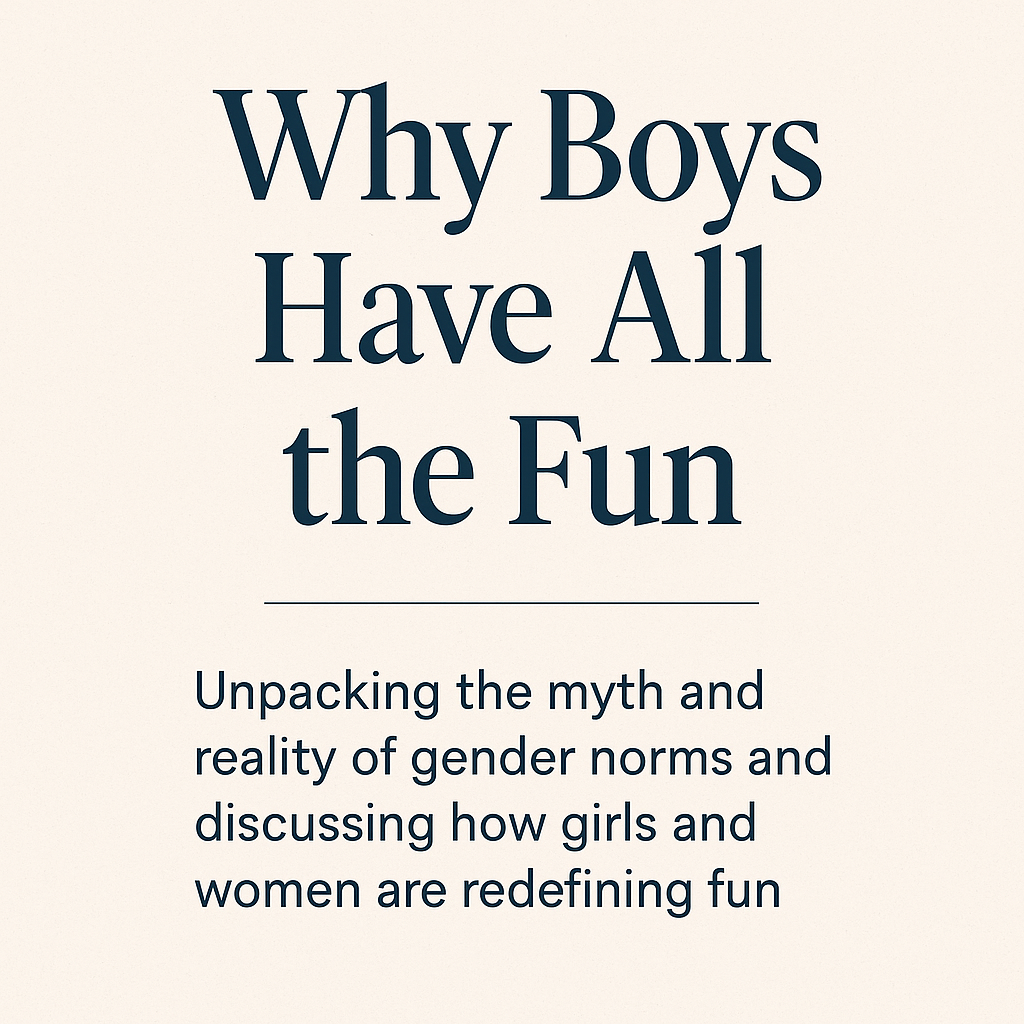
simply amazing, always for you.
The phrase “boys have all the fun” is tossed around a lot — in classrooms, family gatherings, pop culture, and even in memes. It’s often said half-jokingly, half-seriously, to express the idea that boys seem to get away with more, enjoy more freedom, and live a more carefree life compared to girls. But is it really true? Do boys actually have all the fun? Or is this just another outdated stereotype that’s overdue for a reality check?

In this article, we’ll take a deep dive into the roots of this popular notion, the societal dynamics that fuel it, and why it still lingers in modern culture. More importantly, we’ll explore how the definition of “fun” is evolving and how both boys and girls are rewriting the rules of engagement.
Table of Contents
- The Origin of “Boys Have All the Fun”
- How Gender Roles Shape Childhood Experiences
- Freedom, Risk, and Responsibility
- Toys, Media, and the Fun Divide
- Masculinity, Adventure, and Risk-Taking
- Why Girls Are “Left Out” of the Fun
- The Cost of “Fun” for Boys
- How the Narrative Is Changing
- Fun Is for Everyone: Reframing the Conversation
- Beyond the Myth
1. The Origin of “Boys Have All the Fun”
The phrase likely originated from a time when society was starkly divided by gender roles. Boys were expected to be loud, wild, and curious — all considered natural traits of manhood in the making. Girls, meanwhile, were expected to be gentle, reserved, and well-mannered. The social structures reinforced these expectations at every stage: at home, in school, and even in career paths.
As a result, boys were granted more leeway to experiment, make mistakes, and, yes — have more “fun.” This created the perception that being a boy was synonymous with living without constraints, while girls were often told to stay in their lane.
2. How Gender Roles Shape Childhood Experiences
From an early age, children are bombarded with signals about what behavior is “acceptable” for their gender. Boys are praised for being daring, energetic, and assertive. Girls are complimented for being pretty, polite, and obedient. These labels aren’t just superficial — they shape the core experiences of childhood.
- Boys are allowed to get messy, roughhouse, and push boundaries.
- Girls are nudged toward being caregivers, helpers, and rule-followers.
This early conditioning has long-lasting effects. A boy who breaks a vase might be called “spirited.” A girl doing the same might be scolded for being clumsy or irresponsible.
This double standard reinforces the illusion that boys are enjoying life more freely, while girls are kept on a tighter leash.
3. Freedom, Risk, and Responsibility
One major reason the perception of boys having more fun persists is the imbalance of freedom and responsibility. Boys, in many cultures, are given more autonomy than girls. Whether it’s staying out late, traveling alone, or speaking their minds, boys are often trusted to take more risks.
On the flip side, girls are frequently assigned more responsibilities — from helping with house chores to babysitting younger siblings. Even when they’re just kids, girls are often expected to behave like little adults.

This freedom vs. responsibility dynamic tips the scale in favor of boys when it comes to spontaneous, carefree fun.
4. Toys, Media, and the Fun Divide
Walk into any toy store, and the message is clear: boys are supposed to be warriors, builders, and explorers. Girls? They’re homemakers, fashionistas, or princesses. The toy aisle is a microcosm of our society’s expectations.
- Boys’ toys include action figures, Nerf guns, robots, and construction kits — all tools of imagination and adrenaline.
- Girls’ toys often center around beauty, domestic life, or caretaking — which can be limiting and repetitive.
Movies and TV shows don’t do much better. While there’s more diversity now than in the past, many media portray boys as the ones going on adventures, breaking rules, and having all the fun. Girls, though increasingly seen in lead roles, are still often confined to romantic interests, sidekicks, or responsible older sisters.
These portrayals shape how kids perceive what they’re allowed to enjoy.
5. Masculinity, Adventure, and Risk-Taking
The idea that fun equals thrill-seeking, rebellion, or wild behavior is deeply tied to cultural perceptions of masculinity. “Real men” are often portrayed as bold, unafraid, and constantly chasing the next high — whether it’s through sports, travel, or mischief.
This stereotype not only gives boys permission to pursue extreme fun, it expects them to. They’re rewarded socially for being risk-takers and penalized for being cautious or reserved.
But this isn’t always a good thing. While boys might appear to be having more fun, they’re often doing so under pressure — living up to an ideal of masculinity that’s both exhausting and unrealistic.
6. Why Girls Are “Left Out” of the Fun
So why does it often feel like girls aren’t having as much fun? The answer isn’t that they can’t — it’s that society doesn’t always encourage them to.
Girls are often taught to:
- Be careful, not courageous.
- Seek approval, not independence.
- Focus on appearance, not adventure.
These messages are changing, but they still show up in subtle ways. For example, a girl who’s assertive may be labeled “bossy,” while a boy is praised for “leadership.” A girl climbing a tree may be warned it’s not “ladylike,” while a boy is cheered on.
Over time, these experiences add up. They create invisible fences that make it harder for girls to feel like fun — real, uninhibited fun — is meant for them.
7. The Cost of “Fun” for Boys
It’s easy to assume that boys are having all the fun, but what we often miss is the cost. Many boys grow up without the tools to process emotions, build healthy relationships, or ask for help — because those things aren’t seen as “masculine.”
This leads to other problems:
- Emotional suppression
- Higher rates of risky behavior
- Lower likelihood of seeking therapy or support
Yes, boys may have more freedom to explore and play, but that freedom comes with its own risks and responsibilities that aren’t always obvious.
So while girls might face more restrictions early on, boys often pay the price for their perceived freedom later in life.
8. How the Narrative Is Changing
Thankfully, we’re seeing a shift. The old rulebook is being rewritten, and kids today are increasingly encouraged to follow their passions — regardless of gender.
- Girls are dominating in sports, science, and leadership.
- Boys are exploring arts, emotional intelligence, and vulnerability.
Schools are adopting more inclusive curricula. Parents are pushing back against gendered toys. Media is (slowly) embracing more complex, non-stereotypical characters. This cultural evolution is helping dismantle the myth that only boys get to enjoy life to the fullest.
9. Fun Is for Everyone: Reframing the Conversation
At the heart of it, fun isn’t a gendered experience. It’s a human one.
Fun can look like:
- Building a treehouse
- Creating a music playlist
- Traveling solo
- Painting a mural
- Laughing with friends
- Starting a business
- Reading a book that transports you
The real question we should be asking is: What does fun look like for you?
Instead of clinging to the idea that boys have all the fun, we should be asking how we can give every child — regardless of gender — the opportunity to live freely, safely, and joyfully.
10. Beyond the Myth
“Boys have all the fun” is a phrase rooted in outdated gender norms and cultural expectations. It reflects a time when boys were given more freedom and fewer responsibilities — but it doesn’t have to define the present or the future.
Today, the concept of fun is being reimagined in broader, more inclusive ways. Girls are claiming their space in adventurous pursuits, and boys are finding joy in emotional openness and creativity. Fun isn’t limited by gender — it’s limited only by our willingness to challenge stereotypes.
Let’s teach our kids — and remind ourselves — that fun belongs to everyone.

Support Our Website!
We appreciate your visit and hope you find our content valuable. If you’d like to support us further, please consider contributing through the TILL NUMBER: 9549825. Your support helps us keep delivering great content!
If you’d like to support Nabado from outside Kenya, we invite you to send your contributions through trusted third-party services such as Remitly, SendWave, or WorldRemit. These platforms are reliable and convenient for international money transfers.
Please use the following details when sending your support:
Phone Number: +254701838999
Recipient Name: Peterson Getuma Okemwa
We sincerely appreciate your generosity and support. Thank you for being part of this journey!
